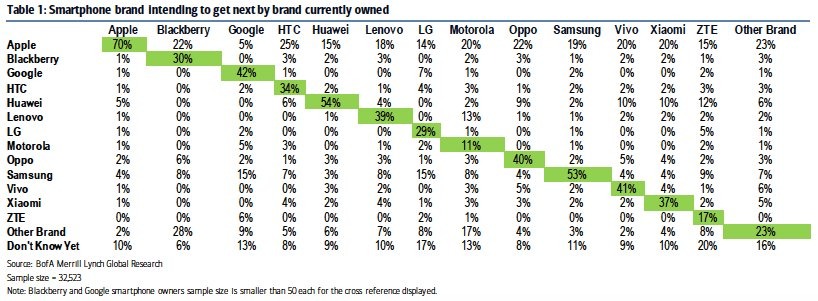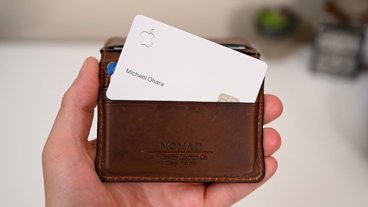About a fifth of Android phone owners plan to switch to an iPhone
Most smartphone buyers tend to stick with the platform they're familiar with. However, new data from Merrill Lynch indicates that a large percentage of top Android brand users now intend to switch to an iPhone in their next purchase.
Analyst Horace Dediu tweeted out a chart of data compiled by Merrill Lynch Global Research on 32,523 smartphone users ranging from Apple, Blackberry, and Google to a series of global Android licensees: HTC, Huawei, Lenovo, LG, Motorola, Oppo, Samsung, Vivo, Xiaomi, and ZTE.
For each maker, the most popular choice among users for their next phone was another model from the same maker. Among iPhone buyers, that figure was 70 percent. For Samsung and Huawei users, 53 and 54 percent respectively planned to stick with their brand. Just 42 percent of Google owners planned to buy another one, while other brand owners expressed even less loyalty.
Apple was the most popular brand among switchers. Of the top five Android brands globally, 15 to 25 percent said they planned to buy an iPhone next. Among HTC buyers, 25 percent said they intended to get an iPhone, nearly as high as the 34 percent who said they'd get another HTC. Only one percent of iPhone buyers indicated interest in buying an HTC.
That asymmetric brand intention played out across other top brands as well. While 19 percent of Samsung owners said they planned to get an iPhone, only 4 percent of iPhone users were looking at Samsung. The most popular alternative brand iPhone users cited was Huawei. But while 5 percent of iPhone buyers said they planned to switch, 15 percent of Huawei owners said they planned to get an iPhone next.
Other top Chinese brands, including Vivo, Oppo, Xiaomi, and Lenovo's Motorola each got one or two percentage points of interest among iPhone buyers, while 20 percent of their users planned to switch in the opposite direction.
Blackberry and Google represented very small groups in the survey, with less than 50 users. Only 30 percent of Blackberry owners planned to buy another Blackberry, but 22 percent planned to get an iPhone. And even among Google buyers, a group that has gone out of its way to pay a premium for Android specifically to support Google, five times as many said they planned to replace theirs with an iPhone compared to the 1 percent of iPhone users who said they intended to buy a phone from Google.
These figures are markedly different from numbers released in 2015 by Ericsson, which studied actual activations of new phones on a monthly basis. It concluded that "the majority of smartphone users remain loyal to their operating system," and that in particular, "owners of high-end models were much more likely to select a new model in the same series from the same vendor than users of lower-end models."
It noted at the time that "around 80 percent of Android and iOS users are loyal to their operating system," while a small trickle of net switchers were continually flowing into the iOS installed base. At new product releases, however, that flow increased, with about twice as many outside users switching to iOS than there were iOS users buying other products.
If Merrill Lynch's data is anywhere close to being accurate, it means that the former models of switchers have fundamentally changed, and that use of Android is no longer protected by brand loyalty. One element of the OS loyalty Ericsson described three years ago has clearly changed — it noted that only 20 percent of Windows Phone users were buying another Windows Phone model.
Windows Phone is effectively gone. Yet among Android brands, the intention to switch to iOS has grown dramatically while loyalty to Android has softened. Other things that have changed in the last three years are the collapse of Android tablets and smartwatches, even as iPad has grown in a shrinking market for tablets. At the same time, Apple Watch has become the most popular watch brand globally while Android watches have all but disappeared.
 Daniel Eran Dilger
Daniel Eran Dilger











 Andrew Orr
Andrew Orr
 Marko Zivkovic
Marko Zivkovic
 David Schloss
David Schloss

 Malcolm Owen
Malcolm Owen

 William Gallagher
William Gallagher
 Mike Wuerthele
Mike Wuerthele






